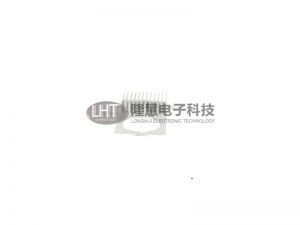
Aluminum alloy is widely used in radiator materials because of its light weight, beautiful appearance, good thermal conductivity and easy processing into complex shapes. There are three main types of aluminum alloy radiator profiles: flat and wide, comb-shaped or fishbone-shaped; round or oval-shaped radiating fins; tree-shaped. As shown in Figure 1. Their common characteristics are: the distance between the radiating fins is short, a groove is formed between two adjacent radiating fins, and the aspect ratio is large; the wall thickness difference is large, the general radiating fin is thin, and the bottom plate thickness at the root is large. Therefore, it brings great difficulty to the mold design, manufacture and production of heat dissipation profiles.
Some of the radiator profiles with smaller dimensions and symmetrical shapes are easier to produce. Most of the radiator profiles are flat and wide, with larger external dimensions, and some are asymmetrical. The aspect ratio of the grooves between the fins is very large. Production is more difficult. In order to successfully produce radiator profiles, it is necessary to cooperate with ingots, molds, and extrusion processes. The alloy used for extruded heat sink must have good extrudability and thermal conductivity. Generally, alloys such as 1A30, 1035 and 6063 are used. Currently, 6063 alloy is commonly used because it has good mechanical properties in addition to good extrudability and thermal conductivity.
The production of aluminum alloy radiator profiles should start with the quality of the ingot, the material and design of the mold, the reduction of extrusion force, and the extrusion process.
1. Quality requirements for ingots
The alloy composition of the ingot must be strictly controlled to ensure the purity of the alloy. For 6063 alloy, the content of Fe, Mg, and Si should be controlled. The content of Fe should be less than 0.2%, the content of Mg and Si are generally controlled at the lower limit of the national standard, the content of Mg is 0.45%-0.55%, and the content of Si is 0.25%-0.35%. The ingot must be fully homogenized to make the structure and performance of the ingot uniform.
The surface of the ingot should be smooth, and no segregation tumor or sandy mud should be allowed. The end face of the ingot should be flat, and can't be cut into steps or the cutting slope should be too large (the cutting slope should be within 3mm). Because the step shape or the cutting slope is too large, when the heat dissipation profile is extruded with a flat die, if there is no design diversion, the ingot directly touches the mold. Due to the uneven end surface of the ingot, some places contact the mold first, resulting in stress concentration. , It is easy to squeeze the tooth shape of the mold, or cause the discharging sequence to be different, and it is easy to cause the phenomenon of mold blockage or poor extrusion molding.
2, the requirements for the mold
Because the mold of the radiator profile is made of many slender teeth, they have to withstand a large extrusion force, and each tooth must have high strength and toughness. If there is a big difference in performance between them, it will be easy. The teeth with poor strength or toughness are broken. Therefore, the quality of mold steel must be reliable, and it is best to use H13 steel produced by a reliable manufacturer or use high-quality imported steel. The heat treatment of the mold is very important. It should be quenched by vacuum heating. It is best to use high-pressure pure nitrogen quenching to ensure that the performance of each part of the mold is uniform after quenching. After quenching, it is necessary to take three tempering to ensure that the hardness of the mold is under the premise of HRC48-52, and it has sufficient toughness. This is an important condition to prevent the mold from breaking teeth.
For the radiator profile to be successfully extruded, the key is that the mold design must be reasonable and the manufacturing must be accurate. In general, try to avoid direct extrusion of the ingot onto the die belt. For the flat and wide comb-shaped radiator profile, design a diversion die with a small middle and large sides to make the metal flow to both sides, reduce the extrusion force on the die working belt, and make the pressure distribution uniform. Because the wall thickness difference of the radiator profile section is large, the difference should be kept correspondingly when designing the mold working belt, that is, the working belt should be particularly enlarged where the wall thickness is large, which can be as large as 20mm-30mm, and the position of the tooth tip should be Break through the routine and minimize work. In short, we must ensure the uniformity of metal flow everywhere. For flat and wide radiators, in order to ensure a certain rigidity of the mold, the thickness of the mold should be appropriately increased. The thickness increase is about 30%-60%. The production of the mold should also be very fine. The empty knife should be symmetrical up and down, left and right, and the middle. The machining error between teeth should be less than 0.05mm. Large machining errors are prone to eccentric teeth, that is, the thickness of the heat sink is uneven. The phenomenon of broken teeth may even occur.
For the more mature design of the section, it is also a better method to use the inlaid alloy steel mold, because the alloy steel mold has good rigidity and wear resistance, and is not easy to deform, which is conducive to the formation of the radiator profile.
3, reduce squeezing force
In order to prevent the mold from breaking teeth, the extrusion force should be reduced as much as possible, and the extrusion force is related to the length of the ingot, the size of the alloy deformation resistance, the state of the ingot, and the degree of deformation. Therefore, the cast rod of extruded heat-dissipating aluminum profile should not be too long, which is about the length of the normal cast rod (0.6-0.85 times). Especially when testing the mold and extruding the first casting rod, in order to ensure the smooth production of qualified products, it is best to use a shorter casting rod, that is, a casting rod that is (0.4-0.6) times the normal length of the casting rod. Try out the mold.
For the cross section of the heat-dissipating profile with complex shapes, in addition to shortening the length of the cast rod, it is also possible to consider the use of pure aluminum short casting for the first trial extrusion, and then use the normal ingot for extrusion production after the trial extrusion is successful.
Ingot homogenization annealing can not only make the structure and performance uniform, but also improve the extrusion performance and reduce the extrusion force, so the ingot must be homogenized annealing. As for the influence of the degree of deformation, since the cross-sectional area of the radiator profile is generally relatively large, and the extrusion coefficient is generally within 40, its influence is relatively small.
4. Extrusion process
The key to the production of radiator profiles is the first trial of the extrusion mold. If possible, you can do a simulation test on the computer to see if the working belt of the mold design is reasonable, and then try the mold on the extruder. The first mold trial is very important. The operator should make the main plunger move forward slowly at a low pressure lower than 8MPa when the main plunger is pushed forward. It is best to have someone watching the exit of the mold with a flashlight and wait for the heat of each extrusion mold. After the sheets are uniformly squeezed into the die hole, the pressure can be gradually accelerated for extrusion. When continuing to squeeze after a successful mold trial, attention should be paid to controlling the squeezing speed to ensure smooth operation. Pay attention to the heating temperature of the mold when producing radiator profiles, and make the mold temperature close to the ingot temperature. If the temperature difference is too large, the temperature of the metal will drop due to the slow extrusion speed during upward pressure, which will easily cause mold blockage or uneven flow rate.

 English
English 中文站
中文站

